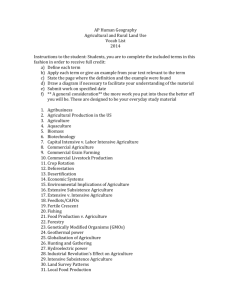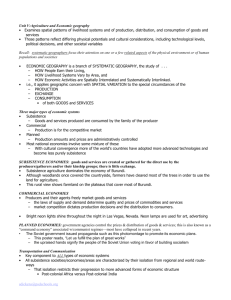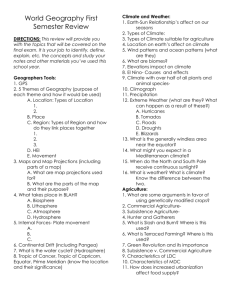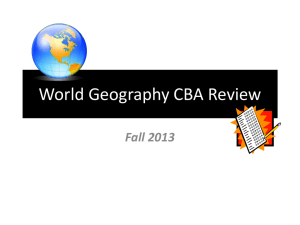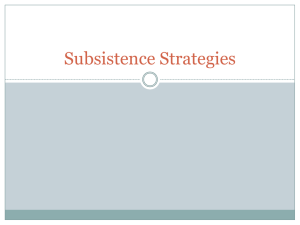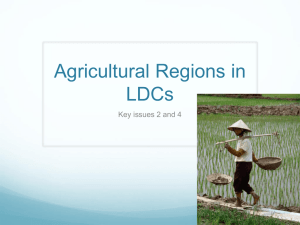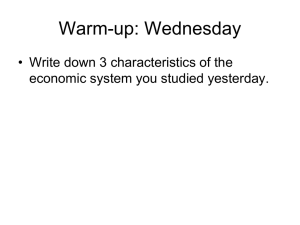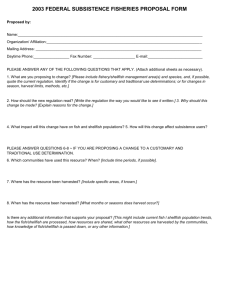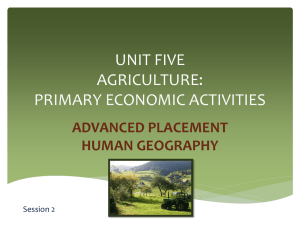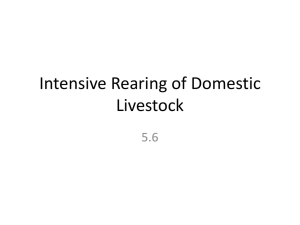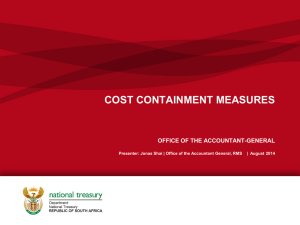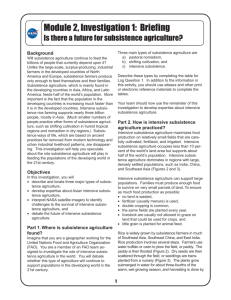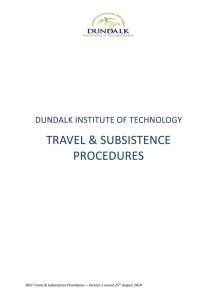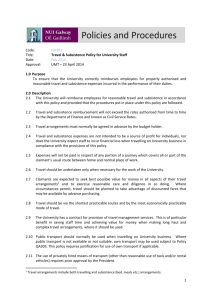Study Guide Objectives for Chapter 8
advertisement
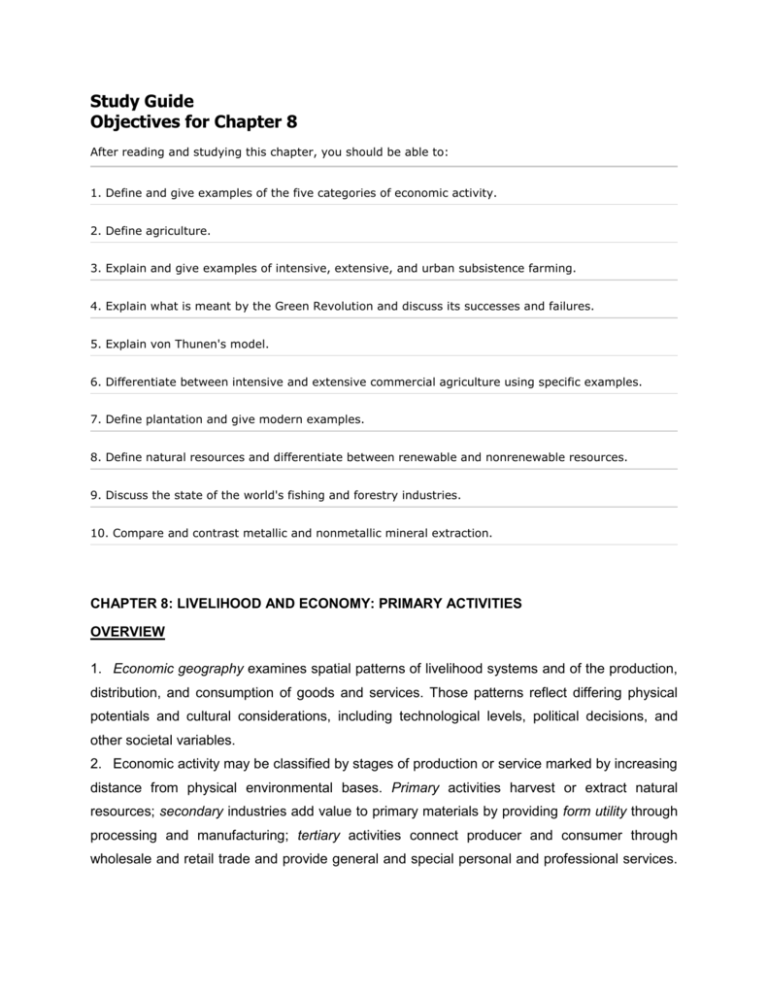
Study Guide Objectives for Chapter 8 After reading and studying this chapter, you should be able to: 1. Define and give examples of the five categories of economic activity. 2. Define agriculture. 3. Explain and give examples of intensive, extensive, and urban subsistence farming. 4. Explain what is meant by the Green Revolution and discuss its successes and failures. 5. Explain von Thunen's model. 6. Differentiate between intensive and extensive commercial agriculture using specific examples. 7. Define plantation and give modern examples. 8. Define natural resources and differentiate between renewable and nonrenewable resources. 9. Discuss the state of the world's fishing and forestry industries. 10. Compare and contrast metallic and nonmetallic mineral extraction. CHAPTER 8: LIVELIHOOD AND ECONOMY: PRIMARY ACTIVITIES OVERVIEW 1. Economic geography examines spatial patterns of livelihood systems and of the production, distribution, and consumption of goods and services. Those patterns reflect differing physical potentials and cultural considerations, including technological levels, political decisions, and other societal variables. 2. Economic activity may be classified by stages of production or service marked by increasing distance from physical environmental bases. Primary activities harvest or extract natural resources; secondary industries add value to primary materials by providing form utility through processing and manufacturing; tertiary activities connect producer and consumer through wholesale and retail trade and provide general and special personal and professional services. Quaternary implies services involving producing, processing, and disseminating information and administering enterprises. The highest-level decision–makers are quinary workers. 3. Three major types of economic systems may be recognized: (1) subsistence, where goods and services produced are consumed by the family of the producer; (2) commercial, where production is for the competitive market; and (3) planned, where production amounts and prices are administratively controlled. Most national economies involve some mixture of these, though with cultural convergence more of the world's countries have adopted more advanced technologies and become less purely subsistence. 4. Agriculture—crop production and livestock rearing—is the most widespread primary activity, occurring wherever environmental conditions permit. Subsistence agriculture implies nearly total self-sufficiency. Nomadic herding and shifting (swidden) cultivation are extensive subsistence agriculture variants, the former involving large land and low capital and labor inputs, the latter relatively high labor inputs in rotating small-plot cultivation. Intensive subsistence farming features very large labor and fertilizer inputs on permanent small plots. 5. Population pressures have caused the extension of agriculture onto marginal areas, with often serious environmental deterioration. The Green Revolution—aimed at increasing yields rather than increasing farmed area—has expanded grain production through new plant varieties, fertilization, herbicides, and other management techniques. The Boserup Thesis investigates the relationship between population growth and the type of agricultural production. 6. Agriculture in advanced economies features specialization, off-farm sales, and reliance on free or controlled markets. The von Thünen agricultural land use model helps explain crop patterns by reference to costs of transportation and production. Truck farms and livestock-grain farming are forms of intensive commercial agriculture. Extensive commercial cropping includes large-scale wheat farms and livestock ranching. Plantation and Mediterranean farming are special forms of commercial cropping. 7. Forestry, fishing, mining, and quarrying are other forms of primary economic activity. Their development depends on the occurrence of perceived resources and the technology to exploit them. Both renewable and nonrenewable resources are subject to overuse. 8. Fishing is a major world source of animal protein. Overfishing and fish stock depletion are expressions of the tragedy of the commons. Exploitation to destruction also threatens large areas of woodland and commercial forest, including the tropical rain forest. 9. Mining and drilling for nonrenewable mineral wealth defines extractive industries. Mineral resources are unevenly distributed in deposits of dissimilar size and quality. Extraction and transportation costs, technologies, and market demand dictate their exploitation. The mineral fuels—especially petroleum—are particularly important in modern economies and in patterns of world trade. The amount of economically recoverable reserves fluctuates upwards and downwards based on their price and cost of extraction. 10. Primary commodities as a group make up a declining share of total international trade but remain dominant in the economies of many of the world’s poorer countries. Commodity prices are volatile; their fluctuations can seriously impede the economic development and endanger the monetary health of developing countries dependent upon their production and export. EXPANDED KEY WORDS LIST agriculture extensive subsistence aquaculture agriculture intensive subsistence beneficiation extractive industry agriculture Boserup thesis FAO land race cartel fertilizer minerals land rent collective farm form utility large-scale wheat commercial economy gathering industry farming commercial forests genetically modified livestock-grain farming coniferous grade livestock ranching continental shelf Green Revolution manufacturing cross pollination gross domestic product marine catch cultural consideration hunting and gathering market economy deindustrialization identified reserve maximum sustainable development industry yield economic geography inland catch extensive commercial intensive commercial Mediterranean agriculture agriculture agriculture metallic mineral mineral fuel shifting cultivation natural resource slash-and-burn nomadic herding cultivation nonmetallic minerals smelting nonrenewable resource specialization off farm sale open seas overfishing physical environment state farm subeconomic reserve subsistence economy swidden planned economy technological development plantation technology polyculture tertiary activity precious stones trade activity primary activity traditional economy processing industry tragedy of the commons proved reserves quaternary activity quinary activity renewable resource reserves resource roundwood secondary activity seed banks semiprecious stones service activity transhumance transport gradient truck farming UNCTAD usable reserve von Thünen model von Thünen rings WTO Key Word Economic geography Primary activity Secondary activity Tertiary activity technology Commercial economy Market economy Planned economy Quarternary activity Quinary activity Subsistence economy agriculture Intensive Agriculture Extensive agriculture Definition Explain with examples Nomadic herding Shifting cultivation Boserup Thesis Green Revolution Von Thunen Model Truck farm Plantation resource Natural resource Renewable resource Non-renewable Resource Extractive Industry Gathering Industry Maximum sustainable Yield Tragedy of the Commons Aqua-culture Useable reserves Discussion Questions (From Fellmann, 270): Practice quizzes available at: https://highered.mcgraw-hill.com/sites/0073522856/student_view0/chapter8/quiz.html Very Cool quizzes and review games at quizlet: http://quizlet.com/10378682/human-geo-chapter-8-fellmann-flash-cards/ For further reading: “Miracle Rice” http://www.livinghistoryfarm.org/farminginthe50s/crops_17.html Loss of Crop Diversity http://www.gmo-journal.com/2011/06/17/loss-of-biodiversity-and-genetically-modified-crops/ 1. What are the distinguishing characteristics of the economic systems labeled subsistence, commercial and planned? Are they mutually exclusive, or can they coexist within a single political unit? Give areal examples. 2. What are some of the ecological consequences of the different forms of extensive subsistence land use? In what world regions are such systems found? What, in your opinion, are the prospects for these land uses and for the way of life they embody? 3. How is intensive subsistence agriculture distinguished from extensive subsistence cropping? Why, in your opinion, have such different land-use forms developed in different areas of the warm, moist tropics? 4. a) Describe the Boserup thesis. b) Do you think it is a valid model for predicting the shift you described in “a” above? c) What other factors might bring about such a shift? 5. Briefly summarize the assumptions and dictates of von Thunen’s agricultural model. How might the land use patterns predicted by the model be altered by: a) an increase in the market price of a single crop? b) A decrease in the transportation costs of one crop but not of all crops? 6. What is the basic distinction between a renewable and non-renewable resource? Under what circumstances might the distinction between the two be blurred, or obliterated? Can you provide an example of such a situation today in the U.S? 7. a) What economic and ecological problems can you cite that do or might affect the viability and productivity of the gathering industries of forestry and fishing? b) What is meant by the tragedy of the commons? How is that concept related to the problems you discerned in “a” above? 8. Mineral fuels a. What are the mineral fuels? b. Why have the mineral fuels been so important in economic development? c. What are the prospects for their continued availability? d. What economic, environmental and social consequences might you anticipate if the price of mineral fuels should i) double? ii) be cut in half?
